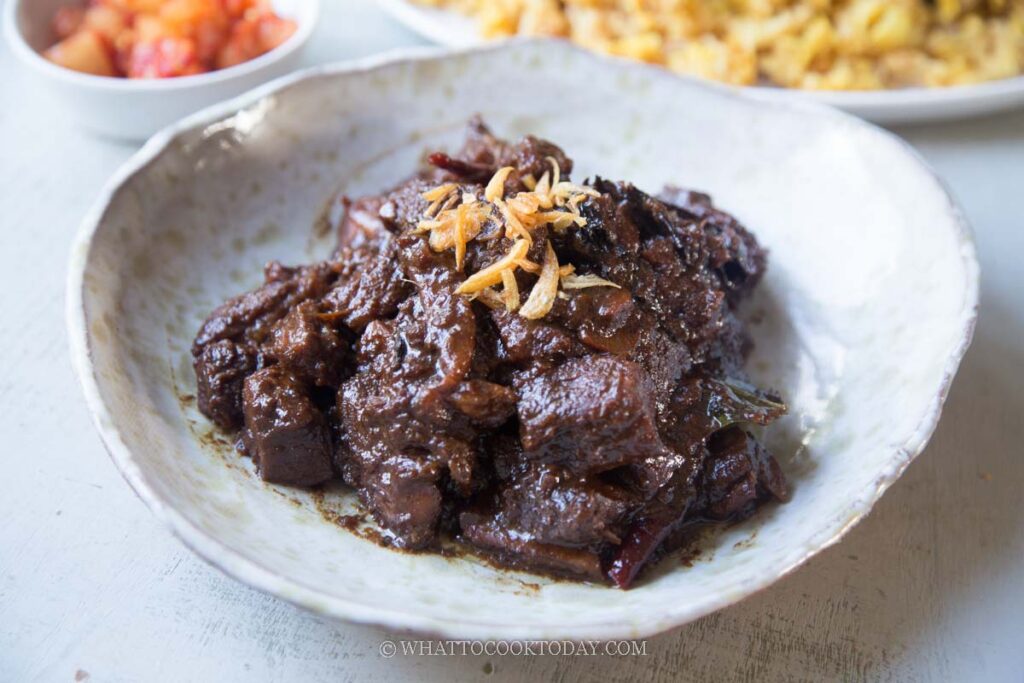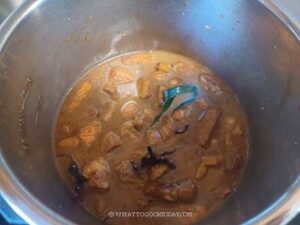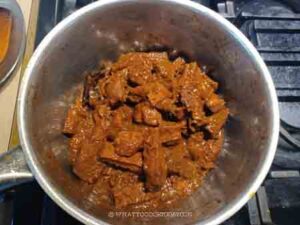This post may contain affiliate links. Please read our disclosure policy.

What is malbi sapi?
Malbi Sapi Palembang is a rich, sweet-savory Indonesian beef stew from South Sumatra. Infused with warm spices, kecap manis, and tamarind, it delivers a perfect balance of sweetness, tanginess, and umami. Traditionally served with fragrant nasi minyak and pineapple sambal, this dish is a comforting and flavorful highlight of Palembang cuisine.
Is malbi sapi similar to rendang sapi?
They may appear to look alike, dark in color and with thick gravy, but they have completely different taste profiles. Rendang sapi is savory and spicy, while malbi sapi is sweet and savory (almost similar taste profile to the Javanese semur dating.
Why malbi sapi stand out?
What sets Malbi Sapi apart from other Indonesian stews is its unique combination of sweet, savory, and tangy flavors, balanced by the richness of slow-cooked beef. The use of kecap manis and spices like nutmeg gives it a distinctly Palembang flavor profile that is comforting and complex.

Malbi Sapi Palembang (Palembang Beef Stew) – Pressure Cooker
Ingredients
- 1 kg beef see notes
- 2 cups water use 4 cups if cooking on the stove
Aromatics to grind:
- 10 shallots
- 5 cloves garlic
- 1 thumbsize ginger
- 2 tsp coriander seeds
- 4 Tbsp cooking oil
Spices and herbs:
- 4 cloves
- ½ tsp ground nutmeg
- 1 tsp ground cinnamon
- ½ tsp ground white pepper
- 2 bay leaves
Seasoning:
- 5 Tbsp kecap manis
- 2 Tbsp gula Jawa or coconut sugar
- 1 Tbsp kosher salt
- 2 Tbsp tamarind juice
Instructions
- Place shallots, garlic, ginger, coriander seeds, and the oil in a food processor or blender and process into a paste consistency

- Turn on the saute mode on Instant pot pressure cooker.
- Scrape the spice paste out into the inner pot of Instant Pot pressure cooker. Use a heavy-bottom large pot if cooking on the stove
- Stir fry until aromatics, about 3 minutes or so. Add the beef into the pot and continue to move things around so the beef pieces mixed with the spice paste

- Add the seasoning and the rest of the spices. Add the water into the pot. It will sizzle. Use your spatula to scrape the bottom of the inner pot of Instant pot pressure cooker to make sure nothing catches at the bottom because it can trigger a "burn" alert

- Close the lid and turn the pressure release valve to seal. Set the timer to 20 minutes and on high pressure. Then do natural release after that
- If cooking on the stove, this may take about 1 to 1 1/2 hours over medium-low heat or until the beef is tender and the liquid has mostly evaporated
Reduce the liquid:
- I have to move the malbi out from the pressure cooker and reduce the liquid on the stove because I need my pressure cooker for something else. Otherwise, you can reduce the liquid in Instant pot so you don't have to dirty another pot 🙂

- Turn saute mode and let it comes to a boil again and let it simmer until most of the liquid has evaporated. This may take another 15-20 minutes. The longer you cook, the thicker the sauce. If you want it more "saucy" you can reduce the cooking time as long as the beef pieces is tender already. The color of the dish gets darker as it cools down

To serve:
- Sprinkle some fried shallots on top of the malbi. Serve malbi with nasi minyak/nasi samin alongside with the pineapple sambal
RECOMMEDED TOOLS
Marv’s Recipe Notes
*Nutrition facts are just estimates and calculated using online tools*

Making Malbi Sapi with Ease: The Pressure Cooker Method
Traditionally, Malbi Sapi is slow-cooked to achieve its signature tenderness and depth of flavor. However, using a pressure cooker significantly shortens the cooking time without sacrificing taste. Here’s an overview of the process:
1. Cook in the Pressure Cooker: The spices are sautéed before adding the beef and water to create a thick sauce. The pressure cooker tenderizes the beef in a fraction of the time.
2. Reduce and Thicken: Once the beef is tender, the stew is simmered uncovered to thicken the sauce, resulting in a glossy, flavorful coating.
Serving Malbi Sapi
Malbi Sapi is traditionally paired with:
1. Nasi Minyak/Nasi Samin Palembang: Fragrant rice cooked with ghee, spices, and sometimes milk or coconut milk. This rice complements the richness of the stew.
2. Pineapple Sambal: A tangy, sweet, and slightly spicy condiment made with fresh pineapple, chilies, and lime juice. Its brightness cuts through the richness of the beef stew beautifully.








2 comments
so easy and yummy!
Hi Yanti, I know right? it’s one of my favorites!